Deborah Swift's Blog, page 41
December 4, 2012
Celebrating the Missing Maidservants
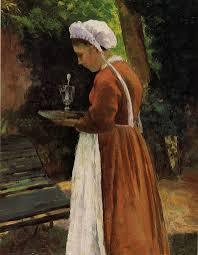 Camille Pissarro 1857 The MaidservantAs you know, I like to write fiction about ordinary people in extraordinary circumstances. No Kings and Queens for me, but the hidden, often unseen, lives of the ordinary people. The missing maidservants so often ignored by historical biographers, but loved by historical novelists as the ideal witnesses to great historical events. With this in mind, my post on recommended books featuring feisty maidservants is over here at One Book at a Time along with a chance to win The Gilded Lily. Why not go over for a look to see which books I've chosen? Have you any historical fiction books you would recommend featuring interesting maidservants?
Camille Pissarro 1857 The MaidservantAs you know, I like to write fiction about ordinary people in extraordinary circumstances. No Kings and Queens for me, but the hidden, often unseen, lives of the ordinary people. The missing maidservants so often ignored by historical biographers, but loved by historical novelists as the ideal witnesses to great historical events. With this in mind, my post on recommended books featuring feisty maidservants is over here at One Book at a Time along with a chance to win The Gilded Lily. Why not go over for a look to see which books I've chosen? Have you any historical fiction books you would recommend featuring interesting maidservants?Below: A Woman and her Maidservant feeding a Pancake to a Dog.
by the Dutch artist Gabriel Metsu (1629-1667)In The Gilded Lily Sadie and Ella cook pancakes or griddle cakes in this way, although their surroundings are not nearly so lavish!

Below: Lady with her maidservant holding a letter by Jan Vermeer

Below: My favourite - The Chocolate Girl by Jean Etienne Liotard
The story behind the commissioning of this painting sounds like a fairy-tale romance. The girl in the portrait, Anna Baltauf, worked as a maidservant in one of the Viennese chocolate shops which had become hugely popular during the 17th and18th centuries. She had little chance of good marriage as her father was too poor to give her a good dowry, however in the summer of 1745, a young Austrian nobleman - Prince Dietrichstein - came into the shop. He fell in love with the Chocolate Girl and asked her to marry him, despite objections from his family As a wedding present to his 'chocolate girl' he commissioned this portrait of his wife wearing the maid’s costume she was wearing when he first set eyes on her. Is this true? I guess we'll never really know.Ella Appleby from The Gilded Lily would have loved this story. It was what she dreamed about for herself! Sadie, her sister, would have gently told her to stop dreaming and to deliver the tray to the customer before the chocolate went cold.

Maidservants spent a lot of time fetching and carrying, but also a large proportion of their time cleaning - here is an interesting post about buttermaking and cleanliness in 17th century. Food for thought!
Published on December 04, 2012 07:28
December 3, 2012
What to do with Snow
 Today you can find the latest review of The Gilded Lily on Luxury Reading, a site dedicated to books of all varieties; fiction, non-fiction and childrens. A treat for bookworms and bibliophiles - and if you don't know the difference between a bookworm and a bibliophile, pop over and be enlightened.
Today you can find the latest review of The Gilded Lily on Luxury Reading, a site dedicated to books of all varieties; fiction, non-fiction and childrens. A treat for bookworms and bibliophiles - and if you don't know the difference between a bookworm and a bibliophile, pop over and be enlightened.There is still a Giveaway for The Gilded Lily open too at the Lit Bitch along with an interview about my writing process.
Meanwhile here are some photos taken during our severe winter in the UK in 2009. Probably not as severe as the Little Ice Age of the 17th Century, but it still took us all by surprise, and provided me with real snow through which I could imagine the scenes of snowbound London in The Gilded Lily.
I remember at that time (2009) there seemed to be an interest in sculpting figures sitting on town benches. I loved these - they are very evocative - something about their ephemeral nature expresses the human condition really well. They are strangely meditative in their white snowy stillness and tell their own story by their solitude or togetherness. Enjoy!


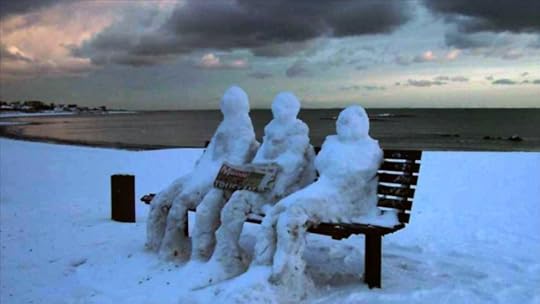
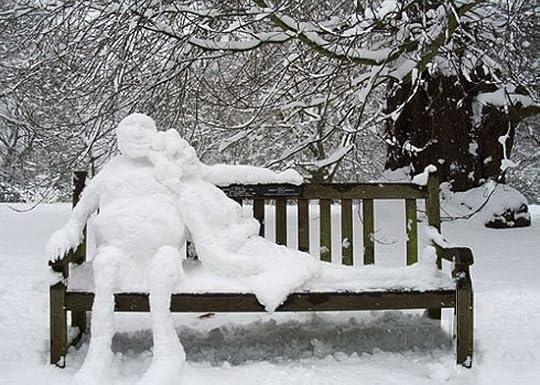
Published on December 03, 2012 09:05
November 29, 2012
17th century transport in Snow - The Gilded Lily
Today The Gilded Lily is being reviewed at The Book Garden blog. Why not take a stroll to the Book Garden and see what the reviwer makes of it. Meanwhile I'm continuing my snowy theme as The Gilded Lily takes place in the little Ice Age, a time when temperatures in London dropped as low as -30 degrees and the Thames froze solid.
In the seventeenth century a sedan chair was a favoured means of transport for a lady. Sadie Appleby is horrified when her sister Ella takes a sedan as this signifies she has gone up in the world. Originally called a 'litter', it was created by lashing two poles to a chair. For royalty or the very well-to-do, it could consist of a bed or couch for the passenger or passengers to lie on. These were carried by at least two porters in front and behind, or by horses.

For the Sedan chair -an enclosed cabin- the porters were known as "chairmen". Sedans were commonly in use until the 19th century and were accompanied at night by link-boys who carried torches. Where possible, the link boys escorted the fares to the chairmen, the passengers then being delivered to the door of their lodgings. There are still houses in Bath and London that have the link extinguishers, shaped like a candle snuffers, outside the door. On this Victorian print featuring life in earlier times you can see the link boy, except there he is carrying a lantern. It shows well how precartious this method of transport might be in snow!
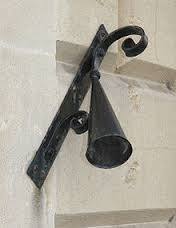 Link extinguisher
Link extinguisher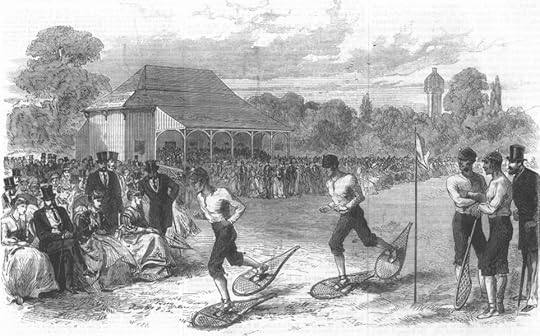
There is no evidence I can find that snow shoes were used in the 17th century in England. But I did find this print of a snow-shoe race outside the Crystal Palace in London in 1867. It must have been quite hard work as the men are bare-chested. What was a common form of transport in snow in the 17th century was a sleigh or sledge. Rich people owned several carriages and at least one sleigh for use in ice and snow. They were beautiful objects but not many examples survive except in diary entries. Here is a horse-drawn sleigh from the Saskatchewan Museum.
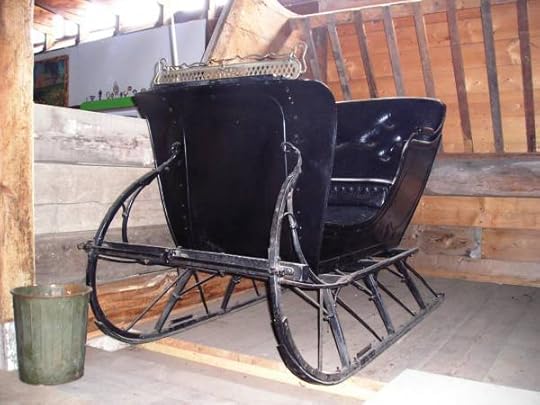

Above - Seventeenth Century sleigh travel (as interpreted by a Victorian artist). It looks very romantic, but probably the realities would have been harsh, with freezing conditions for the occupants, skidding horses, and hidden ruts and obstacles.
And just for fun for my american readers and to complete today's snowy journey I've added this wonderful picture of New York in a Blizzard in 1888. Picures from The Daily Glean There should definitely be a book about this blizzard, it sounds spectacular.
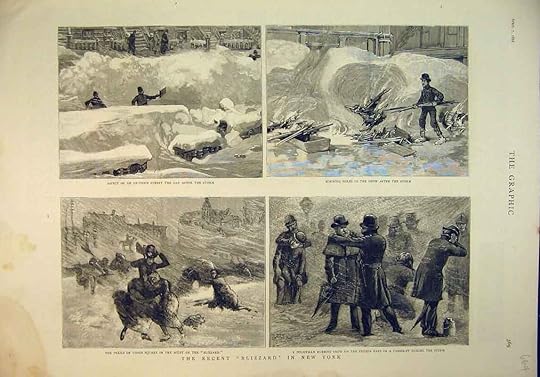
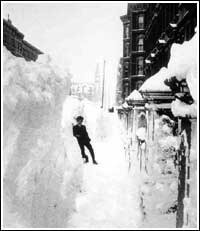 Madison Avenue
Madison Avenue
In the seventeenth century a sedan chair was a favoured means of transport for a lady. Sadie Appleby is horrified when her sister Ella takes a sedan as this signifies she has gone up in the world. Originally called a 'litter', it was created by lashing two poles to a chair. For royalty or the very well-to-do, it could consist of a bed or couch for the passenger or passengers to lie on. These were carried by at least two porters in front and behind, or by horses.

For the Sedan chair -an enclosed cabin- the porters were known as "chairmen". Sedans were commonly in use until the 19th century and were accompanied at night by link-boys who carried torches. Where possible, the link boys escorted the fares to the chairmen, the passengers then being delivered to the door of their lodgings. There are still houses in Bath and London that have the link extinguishers, shaped like a candle snuffers, outside the door. On this Victorian print featuring life in earlier times you can see the link boy, except there he is carrying a lantern. It shows well how precartious this method of transport might be in snow!
 Link extinguisher
Link extinguisher
There is no evidence I can find that snow shoes were used in the 17th century in England. But I did find this print of a snow-shoe race outside the Crystal Palace in London in 1867. It must have been quite hard work as the men are bare-chested. What was a common form of transport in snow in the 17th century was a sleigh or sledge. Rich people owned several carriages and at least one sleigh for use in ice and snow. They were beautiful objects but not many examples survive except in diary entries. Here is a horse-drawn sleigh from the Saskatchewan Museum.


Above - Seventeenth Century sleigh travel (as interpreted by a Victorian artist). It looks very romantic, but probably the realities would have been harsh, with freezing conditions for the occupants, skidding horses, and hidden ruts and obstacles.
And just for fun for my american readers and to complete today's snowy journey I've added this wonderful picture of New York in a Blizzard in 1888. Picures from The Daily Glean There should definitely be a book about this blizzard, it sounds spectacular.

 Madison Avenue
Madison Avenue
Published on November 29, 2012 02:29
November 27, 2012
The Gilded Lily is out in the USA

Thanks to my editor Hope Dellon, and to Silissa Kenney, Loren Jaggers and all the team at St Martin's Press for the publication of The Gilded Lily in the USA - It looks lovely and I'm so pleased it will have a wider readership.
I will be travelling over to the USA to the Historical Novel Conference 2013 in Florida, where I will be part of a panel talking about my journey to publication - 'Making it to Mainstream'.
Other members of the panel are Jenny Barden, Pat Bracewell and Nancy Bilyeau, and we will kept in order by Gillian Bagwell. I'm looking forward to reconnecting with american writers I met at the London Conference and through Macmillan New Writers. I am taking a holiday beforehand with my DH and we're also looking forward to some sightseeing and exploring some of the interesting attractions in the area. (Recommendations welcome - St Augustine is already on my list!)
Meanwhile I'm busy promoting The Gilded Lily and you can find my post on Why the English Took to Tea here
and you can find the latest reviews for The Gilded Lily at
http://layeredpages.blogspot.co.uk/2012/11/england-1660.html
and
http://abookishaffair.blogspot.co.uk/2012/11/hf-virtual-tours-gilded-lily-by-deborah.html
Published on November 27, 2012 03:00
November 22, 2012
Literary Sisters and the Italian Belle Epoque
How would you feel if your sister burnt your manuscript?
My post on the turbulent life of literary sisters The Brontes is over at Enchanted by Josephine, a blog that more often specializes in book reviews and posts about French Royalty and La Belle Epoque. I thought a bit of Yorkshire grit and the wild moors would make a nice contrast over there.
For those of you more used to me talking about the wilds of Westmorland I thought I'd bring a flavour of Enchanted by Josephine over here. Below is a picture from an exhibition of the Italian Belle Epoque. I love this picture of a woman sewing. More similar pictures can be seen at the Dolce Vita blog: or why not visit Enchanted by Josephine where you can click to enter a Giveaway of THE GILDED LILY.
Scroll down for snow!


And for anyone wondering why there is no snow yet on this post (The Gilded Lily is set in the snow of the winter of 1661) - here it is! A picture of Gabrielle Ray who was known as one of the most beautiful women of the Edwardian Era and often photographed. This photo came from a blog dedicated to Gabrielle Ray - click on it to take you there.


My post on the turbulent life of literary sisters The Brontes is over at Enchanted by Josephine, a blog that more often specializes in book reviews and posts about French Royalty and La Belle Epoque. I thought a bit of Yorkshire grit and the wild moors would make a nice contrast over there.
For those of you more used to me talking about the wilds of Westmorland I thought I'd bring a flavour of Enchanted by Josephine over here. Below is a picture from an exhibition of the Italian Belle Epoque. I love this picture of a woman sewing. More similar pictures can be seen at the Dolce Vita blog: or why not visit Enchanted by Josephine where you can click to enter a Giveaway of THE GILDED LILY.
Scroll down for snow!


And for anyone wondering why there is no snow yet on this post (The Gilded Lily is set in the snow of the winter of 1661) - here it is! A picture of Gabrielle Ray who was known as one of the most beautiful women of the Edwardian Era and often photographed. This photo came from a blog dedicated to Gabrielle Ray - click on it to take you there.

Published on November 22, 2012 15:09
November 21, 2012
My snowstorm inspiration - Make time for Poetry, the bigger horizon
Today THE GILDED LILY is being reviewed by Sarah Johnson at her great blog, Reading the Past. The Gilded Lily takes place in London in a freezing winter of the 17thC Little Ice Age, hence my posts on all things snow-related.
As my Christmas Cracker post today I invite you to take a moment to read Mary Oliver's poem. I am a big poetry fan and Mary Oliver is one of my favourite poets who always points to the bigger horizon.Why not buy one of her books or find out more about her from The Poetry Foundation?
Beyond the Snow Belt
by Mary Oliver
Over the local stations, one by one,
Announcers list disasters like dark poems
That always happen in the skull of winter.
But once again the storm has passed us by:
Lovely and moderate, the snow lies down
While shouting children hurry back to play,
And scarved and smiling citizens once more
Sweep down their easy paths of pride and welcome.
And what else might we do? Les us be truthful.
Two counties north the storm has taken lives.
Two counties north, to us, is far away, -
A land of trees, a wing upon a map,
A wild place never visited, - so we
Forget with ease each far mortality.
Peacefully from our frozen yards we watch
Our children running on the mild white hills.
This is the landscape that we understand, -
And till the principle of things takes root,
How shall examples move us from our calm?
I do not say that is not a fault.
I only say, except as we have loved,
All news arrives as from a distant land.

Maria Shriver interviews Mary Oliver
As my Christmas Cracker post today I invite you to take a moment to read Mary Oliver's poem. I am a big poetry fan and Mary Oliver is one of my favourite poets who always points to the bigger horizon.Why not buy one of her books or find out more about her from The Poetry Foundation?
Beyond the Snow Belt
by Mary Oliver
Over the local stations, one by one,
Announcers list disasters like dark poems
That always happen in the skull of winter.
But once again the storm has passed us by:
Lovely and moderate, the snow lies down
While shouting children hurry back to play,
And scarved and smiling citizens once more
Sweep down their easy paths of pride and welcome.
And what else might we do? Les us be truthful.
Two counties north the storm has taken lives.
Two counties north, to us, is far away, -
A land of trees, a wing upon a map,
A wild place never visited, - so we
Forget with ease each far mortality.
Peacefully from our frozen yards we watch
Our children running on the mild white hills.
This is the landscape that we understand, -
And till the principle of things takes root,
How shall examples move us from our calm?
I do not say that is not a fault.
I only say, except as we have loved,
All news arrives as from a distant land.

Maria Shriver interviews Mary Oliver
Published on November 21, 2012 09:21
November 20, 2012
Costume reference for The Gilded Lily - 17thC snow artist Hendrick Avercamp.
I am on tour with THE GILDED LILY today at http://somanybookssolittletimeblog.blogspot.co.uk/
Pop over and see what the reviewer makes of the book. Meanwhile, as part of my Christmas Cracker series of posts, here are some wonderful paintings by Hendrick Avercamp, a dutch painter who excelled at snowscapes and winter landscapes. He was deaf and dumb and known as "de Stomme van Kampen" - the mute of Kampen.
Avercamp's work enjoyed great popularity and he sold his drawings during his lifetime for a good profit. He tinted his drawings with water-colour, and as finished pictures they were pasted into the albums of collectors (an outstanding collection is at Windsor Castle).

I used this research when writing The Gilded Lily - I love the game of ice hockey and the man who appears to be rowing backwards on the ice. The costumes are particularly useful - notice the combination of ruffs and fall collars, and the low broad-brimmed hats.

More articles on Avercamp can be found at The Guardian http://www.guardian.co.uk/artanddesign/jonathanjonesblog/2010/nov/30/hendrick-avercamp-snow-scenes-painter
and at Lines and Colors
http://www.linesandcolors.com/2010/12/31/hendrick-avercamp-and-the-little-ice-age/
Pop over and see what the reviewer makes of the book. Meanwhile, as part of my Christmas Cracker series of posts, here are some wonderful paintings by Hendrick Avercamp, a dutch painter who excelled at snowscapes and winter landscapes. He was deaf and dumb and known as "de Stomme van Kampen" - the mute of Kampen.
Avercamp's work enjoyed great popularity and he sold his drawings during his lifetime for a good profit. He tinted his drawings with water-colour, and as finished pictures they were pasted into the albums of collectors (an outstanding collection is at Windsor Castle).

I used this research when writing The Gilded Lily - I love the game of ice hockey and the man who appears to be rowing backwards on the ice. The costumes are particularly useful - notice the combination of ruffs and fall collars, and the low broad-brimmed hats.

More articles on Avercamp can be found at The Guardian http://www.guardian.co.uk/artanddesign/jonathanjonesblog/2010/nov/30/hendrick-avercamp-snow-scenes-painter
and at Lines and Colors
http://www.linesandcolors.com/2010/12/31/hendrick-avercamp-and-the-little-ice-age/
Published on November 20, 2012 05:42
November 19, 2012
Snow at the Church Stile - A Victorian Christmas Cracker

I am on tour with THE GILDED LILY, which takes place in one of the coldest winters of the Little Ice Age in 1661, so I am celebrating with all things snowy and christmassy here on my blog, even though Christmas is still a month away. I am calling these posts my Christmas Crackers, because I hope my blog tour goes with a bang! (groan)
Today THE GILDED LILY is featured at The Maiden's Court, with a Giveaway and Review.This blog features mainly historical fiction and is a great mix of reviews, posts, movies and more.One of the great features is "Two Sides to Every Story" where people are invited to discuss contentious historical ideas, such as - 'Christopher Columbus - Hero or Brute?'
The print at the top of my post is called A Warm Embrace or Melting Moments and it is dated 1892.
This wonderful print can be purchased at http://www.old-print.com
When writing The Gilded Lily I spent a lot of time looking at all sorts of snowy landscapes and pictures, to give me inspiration for London in snowfall.These are two ideas I didn't use, but aren't they delightful?!
I love this one - 'No getting over, snowed-up at the Church Stile' from 1905 by Lucien Davis, but it is clearly set in earlier times than twentieth century judging by the Empire line dresses.If you like old engravings as I do, the Old Print site could distract you from your work for a long time!

Published on November 19, 2012 08:25
November 6, 2012
The Gilded Lily on Tour - Christmas Crackers

Thanks to Amy Bruno, I am on tour to US and Australian blogs from the 19th November with THE GILDED LILY. Look out for reviews, giveaways and more.
During this time I will be posting a series of short posts by other writers under the banner Christmas Crackers. I invite anyone who wishes to, to contribute a picture, a short extract, a poem or an anecdote with a Christmas or Winter theme.
You can message me on Facebook at http://www.facebook.com/TheGildedLilyBook if you would like to send something or contact me via this blog.
Published on November 06, 2012 06:15
November 5, 2012
The Next Big Thing - A Divided Inheritance by Deborah Swift
I've been tagged in The Next Big Thing by fellow writers Gillian Bagwell and Debra Brown. Do click on their names to find out about Gillian's exhaustive research and Debra's new Victorian romance. I'm instructed to tell you all about my next book by answering these questions and then to tag five other authors about their Next Big Thing. So here I go!What is the working title of your next book? A DIVIDED INHERITANCE, scheduled for publication next September.
Where did the idea come from for the book?
 Viggo Mortensen - AlatristeThree things -
Viggo Mortensen - AlatristeThree things -
one was the idea of exploring how much of our inheritance we take for granted. Our inheritance such as our cultural expectations and identity, and what might happen if these were challenged. I wanted to show that a 17th century woman could survive in a man's world, despite the expectations of the age.
At the same time as I was mulling over this, I came across a wonderful book about 17th century fencing masters and thought it would be interesting to research women who fought using rapiers and to find out more about whether any women used these training techniques. I have an interest in this through practising swordplay through martial arts. The particular method I was researching is an esoteric method designed to produce a kind of 'Renaissance man' - or in this case, woman.
I was also interested in a period of history in Spain where there was massive cultural change and Phillip II expelled a large population of Spanish citizens - an act that divided families and was to impoverish Spain for generations.So this seemed an ideal backdrop for my family drama.
What genre does your book fall under?It is historical fiction - more literary than romance.Which actors would you choose to play your characters in a movie rendition?I was very impressed with the film Alatriste which I watched for some of my research into the Spanish fighting arts, and so I'd go for Viggo Mortensen. I also loved him in Lord of the Rings. For the female lead role I would choose Anne Hathaway who as Jane Austen had the quality of Englishness appropriate for my female lead Elspet Leviston..
[image error]
What is the one-sentence synopsis of your book?A DIVIDED INHERITANCE is set in 1609 and is the story of a woman whose life is turned upside down when a cousin she has never met arrives unannounced at her house. It is a story of courage, hope and the triumph of kinship over adversity. Will your book be self-published or represented by an agency?The book has already been sold to Pan Macmillan via my agent Annette Green.How long did it take you to write the first draft of your manuscript? About eighteen months, of which six months was solid research. I travelled to London to get a sense of the early Jacobean architecture, and also to Seville where I was knocked out by the Alcazar Palace and the wonderful Moorish architecture. I visited museums there and then did lots of further research through archives and by writing to swordplay experts in Spain and the US. Once most of the background research is done I write fairly intensively every morning.What other books would you compare this story to within your genre?I've no idea! Other people compare my books to Philippa Gregory, Tracy Chevalier and Jane Harris - these are all very different writers, so I guess I'm happy to just be myself! I write about ordinary men and women from the past who are caught up in extraordinary circumstances.What inspired you to write this book?I was inspired by the wonderful Moorish architecture of Seville, and its passionate flamenco culture. I wondered how an Englishwoman might cope in Golden Age Spain, which was a hotbed of religious dissent, and where people lived in fear of the Inquisition. I was also inspired by the idea of how deeds from the past might come to bear on one's children, even when they are grown up. And I wanted to explore how people with nothing in common can band together under adversity.What else about your book might pique the reader's interest?Well, here's the blurb so far - which I am working on at the moment. Condensing a very large book into 150 words is a difficult exercise!
About eighteen months, of which six months was solid research. I travelled to London to get a sense of the early Jacobean architecture, and also to Seville where I was knocked out by the Alcazar Palace and the wonderful Moorish architecture. I visited museums there and then did lots of further research through archives and by writing to swordplay experts in Spain and the US. Once most of the background research is done I write fairly intensively every morning.What other books would you compare this story to within your genre?I've no idea! Other people compare my books to Philippa Gregory, Tracy Chevalier and Jane Harris - these are all very different writers, so I guess I'm happy to just be myself! I write about ordinary men and women from the past who are caught up in extraordinary circumstances.What inspired you to write this book?I was inspired by the wonderful Moorish architecture of Seville, and its passionate flamenco culture. I wondered how an Englishwoman might cope in Golden Age Spain, which was a hotbed of religious dissent, and where people lived in fear of the Inquisition. I was also inspired by the idea of how deeds from the past might come to bear on one's children, even when they are grown up. And I wanted to explore how people with nothing in common can band together under adversity.What else about your book might pique the reader's interest?Well, here's the blurb so far - which I am working on at the moment. Condensing a very large book into 150 words is a difficult exercise!
~ London 1609 ~
Elspet Leviston hopes to follow her scholarly father Nathaniel into the lace trade, but already Nathaniel’s past is on its way back to haunt her. Her hopes are threatened by the arrival of her mysterious cousin Zachary Deane – a man who has his own ambitions for Leviston’s Lace.
But wherever Zachary goes trouble seems to follow. So Nathaniel sends him on a Grand Tour, away from the distractions of Jacobean London, and Elspet believes herself to be free of her interfering relation. But when Nathaniel dies, Elspet’s fortunes change dramatically and she is forced to leave her beloved home and go in search of Zachary, determined to claim the inheritance that is rightfully hers.
Under the searing Spanish sun Elspet and Zachary find themselves locked in a battle of wills,But Sevilleis a dangerous place and soon they are embroiled in the roar and sweep of a tragedy that will set them both on a journey of discovery, and unlock for them the mystery of what family really means.Here are some more lovely authors I've tagged to tell you about their Next Big Thing!
Gabrielle Kimm
Len Tyler
Katherine Clements
Charlotte Betts
Sue Millard
Where did the idea come from for the book?
 Viggo Mortensen - AlatristeThree things -
Viggo Mortensen - AlatristeThree things -one was the idea of exploring how much of our inheritance we take for granted. Our inheritance such as our cultural expectations and identity, and what might happen if these were challenged. I wanted to show that a 17th century woman could survive in a man's world, despite the expectations of the age.
At the same time as I was mulling over this, I came across a wonderful book about 17th century fencing masters and thought it would be interesting to research women who fought using rapiers and to find out more about whether any women used these training techniques. I have an interest in this through practising swordplay through martial arts. The particular method I was researching is an esoteric method designed to produce a kind of 'Renaissance man' - or in this case, woman.
I was also interested in a period of history in Spain where there was massive cultural change and Phillip II expelled a large population of Spanish citizens - an act that divided families and was to impoverish Spain for generations.So this seemed an ideal backdrop for my family drama.
What genre does your book fall under?It is historical fiction - more literary than romance.Which actors would you choose to play your characters in a movie rendition?I was very impressed with the film Alatriste which I watched for some of my research into the Spanish fighting arts, and so I'd go for Viggo Mortensen. I also loved him in Lord of the Rings. For the female lead role I would choose Anne Hathaway who as Jane Austen had the quality of Englishness appropriate for my female lead Elspet Leviston..
[image error]
What is the one-sentence synopsis of your book?A DIVIDED INHERITANCE is set in 1609 and is the story of a woman whose life is turned upside down when a cousin she has never met arrives unannounced at her house. It is a story of courage, hope and the triumph of kinship over adversity. Will your book be self-published or represented by an agency?The book has already been sold to Pan Macmillan via my agent Annette Green.How long did it take you to write the first draft of your manuscript?
 About eighteen months, of which six months was solid research. I travelled to London to get a sense of the early Jacobean architecture, and also to Seville where I was knocked out by the Alcazar Palace and the wonderful Moorish architecture. I visited museums there and then did lots of further research through archives and by writing to swordplay experts in Spain and the US. Once most of the background research is done I write fairly intensively every morning.What other books would you compare this story to within your genre?I've no idea! Other people compare my books to Philippa Gregory, Tracy Chevalier and Jane Harris - these are all very different writers, so I guess I'm happy to just be myself! I write about ordinary men and women from the past who are caught up in extraordinary circumstances.What inspired you to write this book?I was inspired by the wonderful Moorish architecture of Seville, and its passionate flamenco culture. I wondered how an Englishwoman might cope in Golden Age Spain, which was a hotbed of religious dissent, and where people lived in fear of the Inquisition. I was also inspired by the idea of how deeds from the past might come to bear on one's children, even when they are grown up. And I wanted to explore how people with nothing in common can band together under adversity.What else about your book might pique the reader's interest?Well, here's the blurb so far - which I am working on at the moment. Condensing a very large book into 150 words is a difficult exercise!
About eighteen months, of which six months was solid research. I travelled to London to get a sense of the early Jacobean architecture, and also to Seville where I was knocked out by the Alcazar Palace and the wonderful Moorish architecture. I visited museums there and then did lots of further research through archives and by writing to swordplay experts in Spain and the US. Once most of the background research is done I write fairly intensively every morning.What other books would you compare this story to within your genre?I've no idea! Other people compare my books to Philippa Gregory, Tracy Chevalier and Jane Harris - these are all very different writers, so I guess I'm happy to just be myself! I write about ordinary men and women from the past who are caught up in extraordinary circumstances.What inspired you to write this book?I was inspired by the wonderful Moorish architecture of Seville, and its passionate flamenco culture. I wondered how an Englishwoman might cope in Golden Age Spain, which was a hotbed of religious dissent, and where people lived in fear of the Inquisition. I was also inspired by the idea of how deeds from the past might come to bear on one's children, even when they are grown up. And I wanted to explore how people with nothing in common can band together under adversity.What else about your book might pique the reader's interest?Well, here's the blurb so far - which I am working on at the moment. Condensing a very large book into 150 words is a difficult exercise!~ London 1609 ~
Elspet Leviston hopes to follow her scholarly father Nathaniel into the lace trade, but already Nathaniel’s past is on its way back to haunt her. Her hopes are threatened by the arrival of her mysterious cousin Zachary Deane – a man who has his own ambitions for Leviston’s Lace.
But wherever Zachary goes trouble seems to follow. So Nathaniel sends him on a Grand Tour, away from the distractions of Jacobean London, and Elspet believes herself to be free of her interfering relation. But when Nathaniel dies, Elspet’s fortunes change dramatically and she is forced to leave her beloved home and go in search of Zachary, determined to claim the inheritance that is rightfully hers.
Under the searing Spanish sun Elspet and Zachary find themselves locked in a battle of wills,But Sevilleis a dangerous place and soon they are embroiled in the roar and sweep of a tragedy that will set them both on a journey of discovery, and unlock for them the mystery of what family really means.Here are some more lovely authors I've tagged to tell you about their Next Big Thing!
Gabrielle Kimm
Len Tyler
Katherine Clements
Charlotte Betts
Sue Millard
Published on November 05, 2012 02:14



